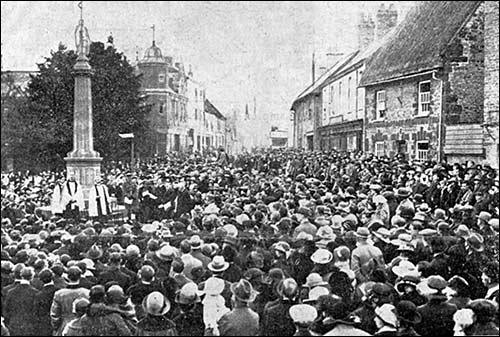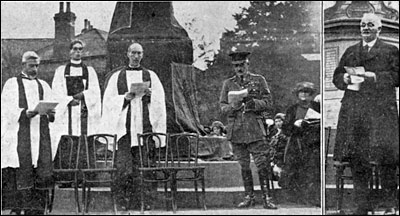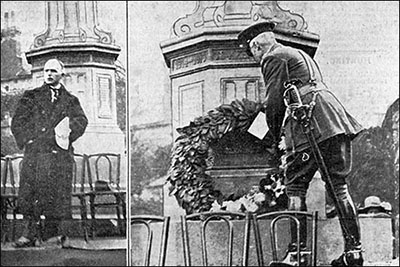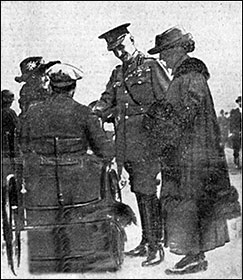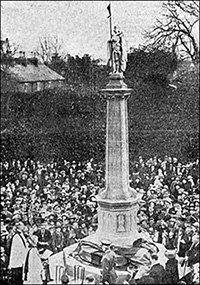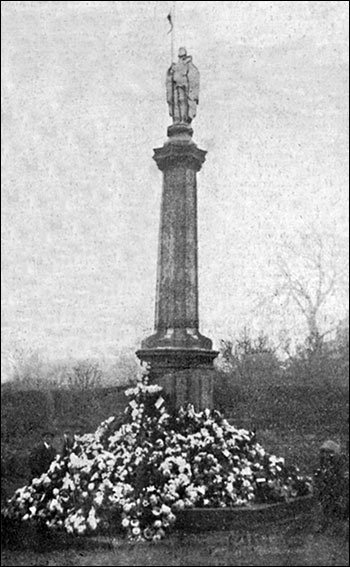| Adapted from an original newspaper cutting from the Kettering Leader, Friday November 17, 1922 , transcribed by Sarah Gilbert | ||||||||||||||
|
||||||||||||||
|
||||||||||||||
| In grateful and loving memory of the men of Burton latimer who responded to the call of duty, and with stout hearts nobly made the great sacrifice in bravely and gallantly defending our hearths and homes, a handsome memorial was on Sunday afternoon unveiled by general Lord Horne, G C.B., K.C.M.G., and dedicated by the Ven. Archdeacon of Oakham. Embodying the sentiment which prompted its erection, the memorial is of a dignified and at the same time simple design. It consists of an octagonal shaft resting on a larger base of similar form, and surmounted by a mail-clad figure of St. George, the patron saint of England, who is represented in a determined attitude standing with one hand clasping the hilt of his partly sheathed sword, the other holding a lance, ready for action against the evils of all time. Indelibly engraved on slate panels on the octagonal base-as on the hearts of their loved ones-and accompanied by the Christian emblem are the names of the 104 valiant men of the village who passed beyond the veil. The ornamentations, particularly at the foot and the head of the column, while not too elaborate, greatly enhance the effectiveness of the whole of the memorial, which is mounted upon three broad steps of Darley Dale stone, reflect considerable credit upon the representative committee, the architects, Messrs. Gotch and Saunders, the sculptor, Mr. A. G. Wyon, Messrs. Morris and Son, Kettering, who erected it, and in fact the whole parish. The site is an admirable one near the centre of the place at the junction of three roads, and it can be seen a good distance along each of them. Hundreds have declared it is one of the best that has been erected, and that whilst it admirably answers its great purpose as a tangible token of
In Honour of the Brave Dead
A Great Assemblance It was a great yet solemn day, not only for the local inhabitants, but for the many visitors who came from Space was reserved for the ex-Service men in the vicinity of the memorial, and when General Lord Horne proceeded to the platform in front of it, accompanied by the Archdeacon of Oakham and others, many hundreds of people were there to take part in the service. Surpliced clergy in addition to the Archdeacon were the Rev. L. H. Lethbridge, Rector of Burton Latimer, and the Rev. G. L. Richardson, formerly Rector of the parish and now of Uppingham ; other welcome visitors being the Rev T. S. Burros, late of Burton Latimer, and the Rev. L. Haley, of Kettering, the latter deputising for the Rev. Evan Williams, of the Fuller Baptist Church, Kettering. The chairman of the Parish Council, Mr. E. Bailey, was accompanied by Councillor J. W. Coles, chairman of the Memorial Committee, Mr. J. Boardman, Mr. A. Barratt, and the rest of his fellow Councillors, and the hon. Secretary, Mr. Fred W. Stokes, clerk to the Council, held a large and magnificent wreath, inscribed :- “A token of gratitude and affection from the parishioners of Burton Latimer.” Also seated were Mr. and Mrs. Harpur, from the Hall; Mr. J. A. Gotch, J.P (representing the architects); Mr. A. G. Wyon (the sculptor); Mr. and Mrs. Morris (Warkton), Mr.G. Watson (Kettering), and many other prominent residents of the district. The Service “Brethren,” said the Rector of Burton Latimer, “we are gathered together here to thank God for our brothers who laid down their lives that honour, truth, and freedom should not perish from the earth. Pray for grace to walk worthy of the good example which they have set before us.” Silence, for this purpose, was kept for a few minutes, and scarcely any sounds arose to break the solemn stillness, although at a later stage rumbling cars on the adjacent roadway now and again caused the speakers to halt a little in their addresses. That familiar hymn, “Rock of ages, cleft for me,” led by a choir from the various places of worship, and a number of instrumentalists under the leadership of Mr. Clarke, the church organist, was heartily sung by the great concourse of people. In clear, ringing tones General Lord Horne remarked upon the suitability of that day for the unveiling, the Sunday after the fourth anniversary of the Armistice when they commemorated the victory gained for right over might, and liberty over oppression. The memorial had been erected in proud memory of gallant sons and good fellows who stood for their country between their homes and a very grave danger, and in heartfelt sympathy with those relatives who had lost their honoured ones and those who had lost their friends. Surely the keynote of such a ceremony was remembrance. It was the keynote of Armistice Day, when poppies were sold throughout the Empire to raise money for the bereaved ones. He could understand people saying they wished to forget the care and sadness, but the glories-no. It seemed to him to be selfish and short-sighted to wish to lay aside all the lessons of the war and to cease to profit by them. A Duty to Posterity A remembrance of the sacrifices and the sufferings was a duty to posterity, for the best way to steer the nation clear of war was to remember the last one, and the ruin it produced. The bereaved relatives and the ex-Service men who served their country did not forget. While the ex-Service men might not wish to dwell upon the horrors of war, they did not want to drive from their minds the nobler aspects, the splendid spirit of comradeship, mutual respect, and admiration that was developed in active service and perfected on the battlefield. And they would not forget the widow and orphan dependents. How many of them heard the last charge of the dying soldier, “Old man, look after the wife and children.” Times were bad, but they would not forget the disabled men, the widow, and the fatherless. They would remember, too, the bodies which lay in the little cemeteries in
The Unveiling Releasing the Union Jack which enveloped the memorial, General Lord Horne made the following declaration. “Now to the Glory of God and in memory of the men of Burton Latimer who gave their lives for King and Country and its causes in the Great War, I unveil this memorial.” All stood silent for a little time gazing upon the monument until the Archdeacon of Oakham broke upon the stillness with the Dedicatory prayer, ending with the words :- “Rest eternal grant unto them and let perpetual light shine upon them. May the Lord of His mercy grant unto us with all the faithful departed rest and peace.”
Reverend Leonard Haley “Remembrance” was the theme of the Rev. L. Haley’s inspiring address. Memory was, he said, the key to their lives. The anniversary of Armistice Day would be nothing to them but for the memory. And that memorial would, in days to come, only mean to them what their memories made it mean. There were great chapters in the history of the emancipation of the race which they could not afford to forget as a nation and as individuals. The men whose lives they commemorated died in the faith, believing that something better was to come, and the remembrance of them should quicken ideals in their own lives. They must, too, perpetuate the memory to prevent a recurrence of war, and make a contribution to the sacredness of life.The hon.secretary (Mr. F. W. Stokes) came forward, and stated that on Saturday night Sir Ruland D. Adkins wired :- “Regret unable to attend ceremony to-morrow. My best wishes for its success.” Prayers having been offered by the Rev. G. L. Richardson, the beautiful memorial was committed to the loving keeping of the Parish Council by the Chairman of the Committee (Councillor J. W. Coles), who made a very appropriate speech. They appreciated, he said, the presence of their distinguished visitors, and thanked them for their gracious and kindly speeches, which gave expression to their feelings, and the thought of the men whose names were recorded in stone and enshrined in their hearts, and would be enshrined in the hearts of generations yet to come. These men, who they were accustomed to meet in the daily walk of life at work and play, displayed a shining example in their ready response to the country’s call. The cheerfulness with which they faced unimaginable danger and the courage with which they made the supreme sacrifice made their memory dear, and a proud heritage to those who were left desolate, whose well-being would be an honourable obligation to them all. The universal readiness with which all in the parish responded to the appeal was a matter of satisfaction to the Committee, for whilst some more richly blessed than others with this world’s goods worthily did their part. The smaller contributions from the pence upwards were no less appreciated. It was in very truth, everyone’s memorial. In committing it to the Parish Council, he believed they would exercise every care to protect it in all its dignity and beauty and that their successors would continue the same proud and affectionate regard for its preservation. In his acknowledgement, Councillor E. Bailey, Chairman of the Parish Council, said he was fully conscious of the responsibility involved. That memorial would be honoured and revered as representing the great sacrifice made by the dear boys, whose career they had watched with interest, and whose memory would never fade. And their hearts went out in sympathy to those who had suffered the loss of their loved ones. The noble acts of their brave heroes could not fail to be an inspiration to them all, and the greatest honour they could do them was by dedicating themselves to the same spirit of unselfishness. Concluding, he said : “I now publicly accept this memorial and commend it to the loving care and keeping of the governing body of the town now and for all time, having every confidence that it will be held in affectionate regard, and that its sanctity and sacredness will always be safeguarded and preserved, and so be held worthy of those who lives we honour and perpetuate to-day, and which will ever live in the hearts of the people of this generation and of generations yet to come.” “While all assembled were heartily singing, “O God, our help in Ages Past” –which formed one of the most inspiring features of the reverent service-the General placed the parishioners magnificent token upon the Memorial. Other floral emblems were put on the steps, on behalf of the ex-Service men by Gunner A. Conroy. R.G.A., and on behalf of the Naval Division by Petty Officer H. Wright. Then with uplifted hand, the Archdeacon of Oakham pronounced the Benediction. All stood-the men with uncovered heads-whilst Private Bradley, of the D Company, sounded the “Last Post” and the “Reveille,” and the memorable service was brought to an end with the first verse of the National Anthem. It was indeed a memorable spectacle when those relatives who had been holding wreaths went forward to place them upon the memorial. No wonder the thought of the dear ones brought forth many a silent tear. Hundreds of lovely floral tributes were placed in position, and in a few minutes the base of the memorial presented a very beautiful picture.
Piled high up the base of the Memorial were a mass of beautiful wreaths brought by loving hands in memory of their dead heroes. A more impressive sight than the mountain of blooms has never been seen in Burton Latimer. Click here to read the names on the cards attached to the wreaths |
||||||||||||||
